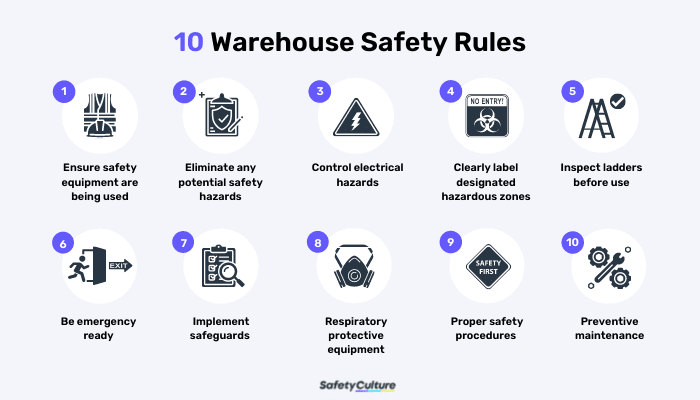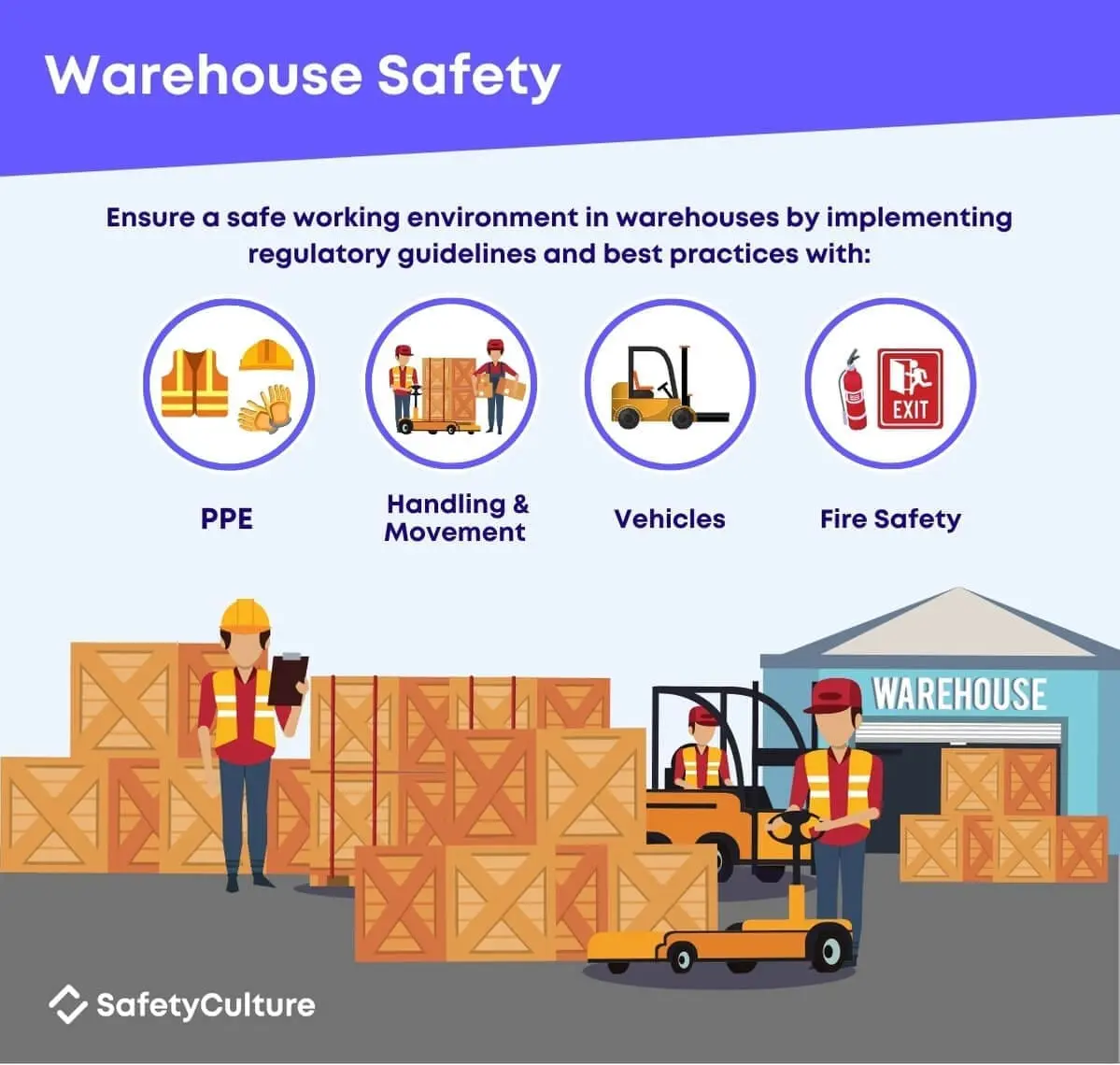Warehouse Safety and Compliance: Best Practices for a Secure and Efficient Warehouse
Warehouse safety and compliance are two of the most critical aspects of any warehouse operation. Ensuring that your warehouse adheres to safety protocols not only helps prevent accidents and injuries but also contributes to operational efficiency and regulatory compliance. A safe and compliant warehouse environment fosters a productive atmosphere, reduces costs related to injuries, and protects both workers and inventory.
In this article, we will explore the essential components of warehouse safety and compliance, including industry regulations, best practices, common hazards, and tips for ensuring a safe and compliant warehouse environment.

Why Warehouse Safety and Compliance Matter
Warehouse safety is not just about following regulations—it’s about creating an environment where employees can work with confidence and without fear of injury. Compliance with safety regulations ensures that your warehouse adheres to legal standards, minimizing the risk of fines and legal issues.
Furthermore, proper safety practices can:
- Reduce workplace injuries: A safe environment helps prevent accidents that can lead to worker injuries or fatalities.
- Improve employee morale: When employees feel safe, they are more productive and engaged in their work.
- Enhance operational efficiency: Safe practices lead to smoother operations, reducing downtime caused by accidents and safety violations.
- Ensure legal compliance: Following safety protocols ensures compliance with industry regulations, avoiding legal penalties.
Key Warehouse Safety Regulations
In many countries, warehouses must comply with various safety standards, such as those outlined by the Occupational Safety and Health Administration (OSHA) in the United States or equivalent regulatory bodies in other countries. These regulations include safety measures for equipment use, fire safety, employee training, and material handling.
1. OSHA Warehouse Safety Regulations
The Occupational Safety and Health Administration (OSHA) is responsible for enforcing safety and health standards for warehouses in the United States. Some key OSHA standards for warehouse safety include:
- Personal Protective Equipment (PPE): Warehouse workers must be provided with appropriate PPE, such as safety shoes, gloves, and hard hats.
- Forklift Safety: Operators of forklifts must be properly trained and certified to prevent accidents related to improper forklift use.
- Fire Safety: Adequate fire exits, fire extinguishers, and emergency plans must be in place to prevent and manage fire-related incidents.
- Hazard Communication: Employees must be informed about hazardous chemicals in the warehouse, and labels and safety data sheets (SDS) must be clearly visible.
- Safe Material Handling: Procedures must be in place to ensure that materials are handled safely, reducing the risk of lifting injuries.
2. International Warehouse Safety Standards
Internationally, warehouses must adhere to regulations like ISO 45001 for occupational health and safety management systems. These standards focus on minimizing risks and enhancing the safety of workers through proactive risk management, safety audits, and employee well-being programs.
Best Practices for Warehouse Safety
Ensuring warehouse safety goes beyond compliance—it’s about creating a culture of safety and promoting safe work habits among employees. Here are the best practices for achieving a safe warehouse environment:
1. Conduct Regular Safety Training
Regular safety training sessions ensure that employees are aware of safety procedures and know how to handle various scenarios. Training should cover:
- Proper material handling techniques.
- Forklift operation and other heavy machinery safety.
- Emergency first aid procedures.
- Hazardous material handling and storage.
Tip:
Interactive training such as hands-on simulations or safety drills can enhance employee understanding and preparedness.
2. Use the Right Equipment
Providing your employees with the right equipment can help prevent many accidents. This includes:
- Properly maintained forklifts and pallet jacks.
- Safety barriers to protect workers from moving vehicles.
- Ergonomically designed tools to reduce the risk of repetitive strain injuries.
3. Maintain Clear Walkways and Signage
Cluttered aisles and unclear pathways can cause accidents and injuries. Ensure that walkways are clear, and that clear signage is visible in all areas of the warehouse to guide employees safely.
- Place safety signs that indicate emergency exits, fire safety equipment, and hazard areas.
- Use floor markings to direct pedestrian traffic away from vehicle zones.
4. Ensure Fire Safety Compliance
Fire safety should always be a top priority. Some critical fire safety measures include:
- Regular inspections of fire extinguishers and sprinklers.
- Unobstructed fire exits.
- Fire drills for employees to ensure they know what to do in case of a fire.

5. Implement an Injury Reporting System
Encourage workers to report any injuries or near-misses immediately. This system should be easy to use and ensure that all incidents are documented and addressed.
6. Perform Regular Safety Inspections
Regular safety inspections should be performed to identify and address any potential hazards before they result in an accident. A warehouse safety audit can help evaluate your adherence to safety standards and highlight areas for improvement.
Common Warehouse Safety Hazards
Even with a comprehensive safety program, it’s essential to be aware of the common hazards that occur in warehouses. Identifying and mitigating these hazards is key to maintaining a safe environment.
1. Slips, Trips, and Falls
Uneven floors, spills, and clutter can lead to falls, which are among the most common warehouse injuries. Regularly clean floors, remove obstacles, and mark wet or slippery areas clearly to avoid accidents.
2. Forklift Accidents
Forklifts are a significant cause of warehouse injuries. Ensure all forklift operators are trained and certified, and implement strict protocols for safe forklift operation.
3. Repetitive Strain Injuries
Lifting, bending, and reaching repeatedly can cause musculoskeletal injuries. Provide ergonomic tools, encourage proper lifting techniques, and rotate tasks to prevent injuries from overuse.
4. Falling Objects
Improper stacking or storing of materials can lead to falling objects, which pose significant risk. Ensure that storage racks are well-maintained and that heavy items are stored securely.
5. Exposure to Hazardous Materials
Warehouses that handle chemicals, flammable materials, or toxic substances must ensure that employees are trained in proper handling techniques and equipped with the necessary PPE.
How to Stay Compliant with Warehouse Safety Regulations
Compliance with safety regulations is critical for any warehouse operation. To maintain compliance:
- Stay Updated on Regulations: Warehouse safety regulations can change, so it’s important to stay informed about new or updated rules from agencies like OSHA or your country’s relevant regulatory body.
- Develop a Compliance Program: Create and maintain a detailed compliance program that includes regular safety audits, employee training, and documentation of compliance efforts.
- Work with Legal Advisors: Consult with safety experts or legal advisors to ensure that your warehouse meets all local, state, and federal safety standards.
- Leverage Technology: Utilize warehouse management systems (WMS) and safety software to automate compliance checks and track safety performance.
FAQ: Warehouse Safety and Compliance
Q1: What is the most common cause of warehouse accidents?
A1: The most common cause of warehouse accidents is slips, trips, and falls, often due to wet floors, cluttered aisles, or poor lighting.
Q2: How often should warehouse safety training be conducted?
A2: Safety training should be conducted regularly—ideally, annually, with additional training sessions when new equipment or procedures are introduced.
Q3: How can I reduce forklift accidents in my warehouse?
A3: Ensure that all forklift operators are properly trained, implement clear traffic lanes, and regularly inspect equipment to maintain safety standards.
Q4: How do I handle hazardous materials safely in my warehouse?
A4: Ensure that all hazardous materials are properly labeled, stored in designated areas, and that employees are equipped with the correct PPE and training.
Conclusion
Warehouse safety and compliance are essential for creating a secure and efficient working environment. By following best practices, staying compliant with regulations, and fostering a safety-conscious culture, you can minimize risks, prevent injuries, and ensure smooth operations. Prioritize safety today to protect your workers and ensure the success of your warehouse in the long term.
For more information on safety compliance in warehouses, check out the following resources:

